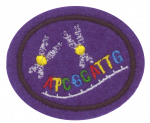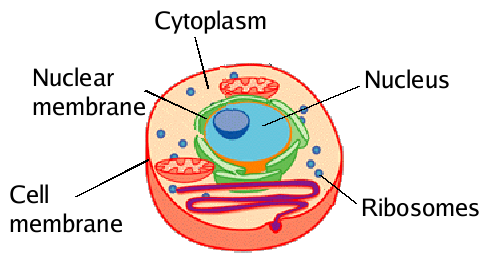AY Honors/Heredity/Answer Key/es
| Herencia | ||
|---|---|---|
| Asociación General
|
Destreza: 3 Año de introducción: 2004 |
|
Requisitos
1
2
3
3a
3b
4
4a
4b
4c
4ci
4cii
4ciii
4civ
4cv
4cvi
4cvii
4cviii
4d
5
5a
5b
5c
6
6a
Every cell in your body has 46 identical chromosomes that are unique to you (commonly known as your DNA - what gets matched on a crime show). This is called a diploid number of chromosomes or 2n. However, when you make sex cells (egg or sperm) through meiosis, the cells will have half the normal body cell number, so in humans, 23. This is called haploid (hap and half sound alike, which helps us remember it.) This is represented by 1n. 23 chromosomes from the mother+23 from the father=46 total in the offspring.
6b
6c
7
See Protein Synthesis for more information on this. It is much easier to understand an animation like this one.
In transcription DNA copies codes of thymine, adenine, cytosine and guanine into sequences that result in the formation of genes. An example of a sequence is AT-CG-AT-TA-TA-CG-GC-GC-AT representing base pairs of adenine/thymine and guanine cytosine.
Thymine (T) will bond with adenine (A) and only adenine (TA or AT). Cytosine (C) will bond with guanine (G) and only guanine (CG or GC).
Ideas for demonstrating this process include using the candy "dots" or "Mike and Ike's." You can use them with a toothpick to hold them together representing the sideways bonds and place them end to end to make a double helix around a dowel. Cytosine - red / Adenine - yellow / Thymine - orange / Guanine - green.
8
Mutation is any change in an organism's genetic material (DNA) caused by a mutagen, which is any material that drives this change.
Mutation can cause changes both big and small in a gene, either by point mutations and insertion/deletion of nucleotides on the small end of the scale or by mutations that have larger effects such as the duplication of a certain gene, the translocation of a certain chromosome, or the inversion of a chromosomal segment.
Many mutations are meaningless and inneffective as there are up to four triplet codes that each code for the same amino acid, and so if one base is changed, the overall result is unchanged, and the protein will be as if the mutation never happened. However, if multiple mutations occur on the same DNA or RNA strand, this can result in improperly built RNA which translates into improperly formed proteins and even malformed body structures and uncontrolled cell growth (cancer). See Protein Synthesis for more information on this.
A mutation is a shift in base pairs (which is the CG / AT) during transcription. It can be a deletion, subtraction or translocation.
9
Here is a list of genetic disorders and famous people who had/have them. You can easily search for more examples, or just pick one and find a story about the person you chose. You can tell the story to the others working on the honor (which will make an interesting exchange), or maybe type it up as a blog post if you are working on this honor independently.
- Color-blindness
- Bill Clinton, former President of the United States, and Bob Dole, Former Majority Leader of the U.S. Senate. These two ran against each other in the 1996 Presidential election, and during their debates, the colors normally used had to be changed to accommodate them both.
- Cystic fibrosis
- Grégory Lemarchal, French pop singer, died from the illness in 2007
- Frankie Abernathy, actress in Real World: San Diego, died in 2007
- Lisa Bentley, Triathlete
- Down syndrome
- Stephane Ginnsz, actor (Duo (film)) First actor with Down syndrome in the lead part of a motion picture.
- Chris Burke, actor (Life Goes On) and autobiographer
- Andrea Friedman, actor (Life Goes On), guest appearances on many other shows
- Pascal Duquenne, actor (Le Huitième Jour aka The Eighth Day, Toto le héros aka Toto the Hero)
- Anne de Gaulle (1928-1948), daughter of Charles de Gaulle
- Hemophilia
- Ryan White, famous for his struggle against AIDS. Ryan had hemophilia and got AIDS from the blood-clotting medicine he took.
- Queen Victoria was a carrier of Hemophilia B. Two of her five daughters were also carriers and married into other royal families in Europe. They passed Hemophilia through various royal families such as Spain, Germany, and Russia. This is why Hemophilia is known as the Royal Disease. Her son Leopold died from a fall made fatal by Hemophillia.
- An extensive list of famous hemophilics.
- Parkinson's Syndrome (formerly referred to as Parkinson's Disease)
- Michael J. Fox - Actor
- Cassius Clay (aka Muhammad Ali) - Former heavyweight boxing champion and Olympic gold medalist.
- Janet Reno, former Attorney General of the United States
- Huntington's Disease
- Woody Guthrie
- Sickle Cell Anemia
- Tiki Barber - American Football Player
- Spina bifida
- Olympian and eight-time Boston Marathon winner Jean Driscoll[1]
- 1980s rock star, John Mellencamp
- Welsh Paralympian, Tanni Grey-Thompson
- U.S. country music singer, Hank Williams
- Tay-Sachs disease
10
Biological Heredity is not the only factor contributing to your character- it is proven in studies that a personality of a person, and who they are, is determined by not only their genes, but also by their environment (way they are brought up).
As Adventists and Pathfinders our character should be shaped by our parents, our faith, our good deeds and by the temptation and sin, all of which can change our character.
11
- Desire of Ages, p. 307 Inside of us by faith
"True character is not shaped from without, and put on; it radiates from within. If we wish to direct others in the path of righteousness, the principles of righteousness must be enshrined in our own hearts. Our profession of faith may proclaim the theory of religion, but it is our practical piety that holds forth the word of truth. The consistent life, the holy conversation, the unswerving integrity, the active, benevolent spirit, the godly example,--these are the mediums through which light is conveyed to the world."
- Desire of Ages, p. 122/123 Christ's character in you will see you through the end times.
"In our own strength it is impossible for us to deny the clamors of our fallen nature. Through this channel Satan will bring temptation upon us. Christ knew that the enemy would come to every human being, to take advantage of hereditary weakness, and by his false insinuations to ensnare all whose trust is not in God. And by passing over the ground which man must travel, our Lord has prepared the way for us to overcome. It is not His will that we should be placed at a disadvantage in the conflict with Satan. He would not have us intimidated and discouraged by the assaults of the serpent. "Be of good cheer," He says; "I have overcome the world." John 16:33."
- Testimonies Vol. 4, p. 439 Character traits are transmitted to us from our parents.
"It will be well to remember that tendencies of character are transmitted from parents to children. Meditate seriously upon these things, and then in the fear of God gird on the armor for a life conflict with hereditary tendencies, imitating none but the divine Pattern."
Referencias
- Categoría: Tiene imagen de insignia
- Adventist Youth Honors Answer Book/Honors/es
- Adventist Youth Honors Answer Book/es
- Adventist Youth Honors Answer Book/Skill Level 3/es
- Categoría: Libro de respuestas de especialidades JA/Especialidades introducidas en 2004
- Adventist Youth Honors Answer Book/General Conference/es
- Adventist Youth Honors Answer Book/Health and Science/es
- Adventist Youth Honors Answer Book/Health and Science/Primary/es
- Adventist Youth Honors Answer Book/Stage 0/es


